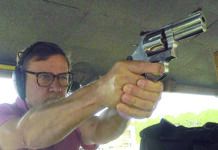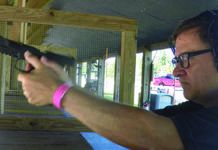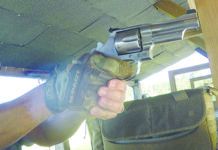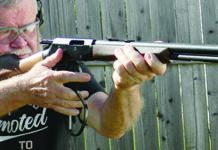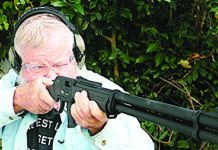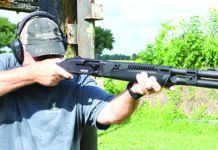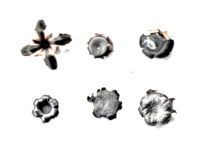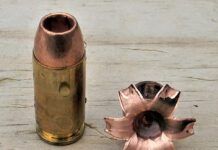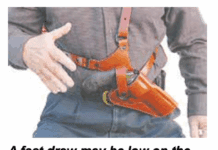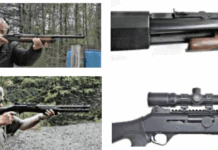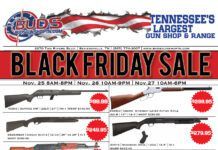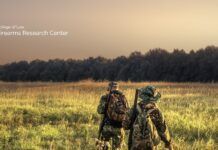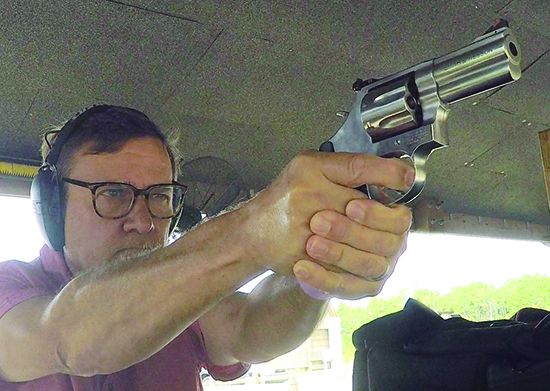When the FBI carried 357 Magnum revolvers between 1981 and 1991, the standard issue was a S&W Model 13 with a medium-sized round-grip K-frame and a 3-inch barrel. Consider the Model 13 a benchmark for a concealed-carry 357 Magnum revolver. It offers better shootability than a smaller-frame revolver with a smaller grip, yet doesn’t feel like a brick on your hip when you carry it.
Medium-frame revolvers are exactly what they sound like. They are an in-between frame that is larger and heavier than a small-frame revolver, yet smaller and less weighty than a large-frame revolver. The extra weight makes medium-frame revolvers easier to shoot well and offers better help with recoil management, while still allowing the revolver to be concealed more easily. You could argue that medium-frame revolvers are just right for concealed carry, offering the hand-filling performance of a large-frame revolver yet sitting in a holster lightly enough to carry all day.
In this vein, we opted to review three medium-frame 357 Magnum revolvers and chose the following: a Colt Python Classic PYTHON-SP2WCTS 357 Magnum, $1317; a Henry Firearms Big Boy Revolver H017BDM, $722; and a Smith & Wesson Model 686 Plus 164300, $896.
We also wanted to see what velocity/energy we would gain or lose with revolvers equipped with a 4-inch, 3-inch, and 2.5-inch barrel. A 3-inch barrel is the benchmark for optimal performance in a medium-size 357 Magnum, according to the FBI.
Even though the three revolvers were new, we checked the cylinder-to-frame headspace and barrel-and-chamber alignment. As suspected, both were in spec. The cylinder-gap spec can indicate whether a revolver will spit out debris that can be felt on your hands. The normal cylinder-gap range is 0.004-0.007 of an inch, measured with a feeler gauge. The Henry had a gap of 0.55 inch, the Colt measured 0.004 inch, and the S&W was a very tight 0.002 inch. We assumed we would not have any problems with splash with these revolvers, and we didn’t. We did note that the S&W may need to be maintained more often if the shooter uses only lead bullets, which may build up deposits on the cylinder face and gum up the works due to the 0.002-inch gap. Here is what we found after the shooting was done.
Smith & Wesson Model 686 Plus 164300 357 Magnum
$896
Gun Tests grade: A [OUR PICK]
The Model 686 Plus has a smooth double-action trigger pull, a rubber grip that absorbs recoil, large sights, and good accuracy. The 3-inch barrel is an optimal compromise between 4- and 2.5-barrel revolvers. The seven-round capacity is a definite plus. This is a good choice for an everyday carry revolver.
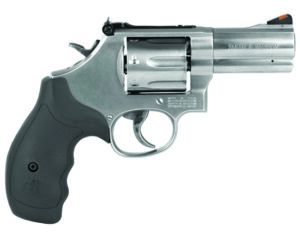
| Action Type | DA/SA |
|---|---|
| Overall Length | 8.1 in. |
| Barrel Length | 3.0 in. |
| Barrel Rifling Twist Rate | 1:18.7 in. |
| Sight Radius | 4.9 in. |
| Overall Height | 6.0 in. |
| Maximum Width | 1.5 in. |
| Weight Unloaded | 35.8 oz. |
| Weight Loaded | 39.0 oz. |
| Cylinder Gap | 0.002 in. |
| Capacity | 7 |
| Frame | Satin stainless steel |
| Barrel | Satin stainless steel |
| Cylinder | Satin stainless steel |
| Frame Front Strap Height | 2.7 in. |
| Frame Back Strap Height | 3.9 in. |
| Grip | Textured rubber w/finger grooves |
| Grip Thickness (Maximum) | 1.2 in. |
| Grip Circumference (Maximum) | 5.0 in. |
| Front Sight | Red ramp, pinned |
| Rear Sight | Adjustable notch |
| Trigger Pull Weight (Double Action) | 11.0 lbs. |
| Trigger Pull Weight (Single Action) | 4.6 lbs. |
| Trigger Span (Double Action) | 3.6 in. |
| Trigger Span (Single Action) | 3.0 in. |
| Safety | Internal rebound, hammer block |
| Warranty | 1 year |
| Telephone | (800) 331-0852 |
| Website | Smith-Wesson.com |
| Made In | U.S. |
The Model 686 had been in production since 1980, then S&W decided to up the capacity ante with the 686 Plus in 1997 with a seven-round capacity. What’s impressive about the 686 Plus is S&W increased round capacity without increasing the size of the revolver, and with the addition of the extra chamber, the cylinder rotated smoothly and precisely, which is what we experienced with the 3-inch-barrel 686 Plus.
The foundation for the 686 and 686 Plus is S&W’s medium-sized L-frame, which is an enhanced and beefier version of S&W’s K-frame and the last of the revolver frames purpose-built for law enforcement. The 686 was also S&W’s answer to Colt’s Python. With the full underlug barrel and medium-sized frame, it looked and performed similarly to the Colt Python but cost a lot less. The U.S. Border Patrol, Immigration and Naturalization Service, and U.S. Customs Service all issued 686 revolvers. It was a very popular weapon with LE and civilians alike.
The sample we tested here was equipped with a 3-inch barrel, though 2.5-, 4-, and 6-inch-barrel models are available. S&W’s Performance Center also offers tricked-out versions with slick actions and different grips. Our standard Model 686 Plus came equipped with a rubber grip with palm swells and finger grooves. This was the most comfortable grip of all the revolvers tested. It allowed for a high hold that allows the shooter to control the muzzle flip of revolver under speed. The left side of the grip is scooped out so speed loaders can be used.
The 3-inch barrel has a full lug and that extra weight helps with muzzle flip. The front sight is a red-insert ramp with a serrated face to reduce glare. The rear sight is adjustable, with a user-facing side that’s serrated. The rear notch is plenty wide, so picking up the front sight is fast and simple.
This seven-shooter is constructed of stainless steel with a satin finish. The trigger and hammer are blued and contrast nicely with the gun. The trigger face is smooth, so stroking the trigger in double action is slick. In double-action mode, the trigger broke at 11 pounds, but it felt like less due to the grip and the smoothness of the action. In single-action mode, the trigger broke at a crisp 4.6 pounds. The full hammer spur is checkered for a sure, no-slip grip when cocking the hammer.
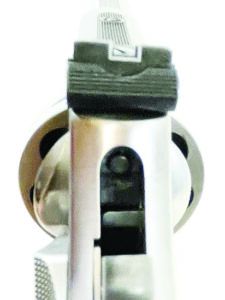
The seven-chamber cylinder is a marvel, and we appreciate the extra round. The ejector is knurled on the end and rounded. It ejected empties with authority each time. The cylinder locks up at the rear and at the end of the ejector rod via a pin in the ejector shroud. The crane-to-frame fit was tight, and there was hardly any wiggle in the cylinder. The 686 Plus is built for rugged use and high-volume 357 Mag shooting, though we suspect milder 38 Special ammo is mostly fired through these revolvers during training and practice.
Going hot at 25 yards, the Magtech 38 Special 158-grain load gave us a best group of 1.8 inches; 2.5 was the average. Moving up the ammo food chain to 357 Magnum, the best group was with Federal 158-grain Hydra-Shoks at 1.5 inches; average was 2.0 inches. Accuracy eroded a bit with the 125-grain Winchester rounds, which had a best of 2.4 inches and averaged 3.0 inches. The 686 Plus was easily the most accurate of the revolvers tested. Shooting for speed at 7 yards, the 686 Plus was not only very comfortable to shoot even with 357 Magnum ammo, it allowed for a high grasp, which helped with muzzle flip. The large sights are fast to acquire. The grip was very comfortable, even with hotter 357 ammo. It seems that the extra chamber increases the speed of the 686 Plus since there is less rotation between chambers. We liked the extra round in the cylinder. We could stage the trigger without effort for surgical A-zone shots and then pull through to fire. There were no issues. Cases ejected smoothly, and the cylinder latch was easy to operate.
The 3-inch barrel is an optimal compromise between 4-inch and 2.5-inch-barrel revolvers, as we saw in the data. The 3-inch barrel also offers a usable sight radius and ease in concealability.
Our Team Said: The double-action trigger on the 686 Plus was smooth, and the single-action pull was serviceable. The rubber grip absorbs recoil, large sights increase follow-up shot speed, and accuracy was very good. The seven-round capacity is a definite Plus. We would happily use this as an EDC revolver.
| 38 SPECIAL AND 357 MAGNUM RANGE DATA | |||
|---|---|---|---|
| 38 Special Magtech 158-grain LRN 38A | Colt Python Classic | Henry Big Boy Revolver | S&W Model 686 Plus |
| Average Velocity | 772 fps | 785 fps | 780 fps |
| Muzzle Energy | 209 ft.-lbs. | 216 ft.-lbs. | 214 ft.-lbs. |
| Smallest Group | 2.67 in. | 2.57 in. | 1.83 in. |
| Average Group | 3.15 in. | 2.64 in. | 2.57 in. |
| 357 Magnum Winchester PDX1 125-grain BJHP | Colt Python Classic | Henry Big Boy Revolver | S&W Model 686 Plus |
| Average Velocity | 1129 fps | 1128 fps | 1126 fps |
| Muzzle Energy | 506 ft.-lbs. | 353 ft.-lbs. | 352 ft.-lbs. |
| Smallest Group | 2.26 in. | 2.79 in. | 2.49 in. |
| Average Group | 2.94 in. | 3.19 in. | 3.05 in. |
| 357 Magnum Federal Hydra-Shok 158-grain JHP P357HS1 | Colt Python Classic | Henry Big Boy Revolver | S&W Model 686 Plus |
| Average Velocity | 1200 fps | 1203 fps | 1214 fps |
| Muzzle Energy | 506 ft.-lbs. | 509 ft.-lbs. | 517 ft.-lbs. |
| Smallest Group | 1.92 in. | 2.94 in. | 1.51 in. |
| Average Group | 1.95 in. | 3.13 in. | 2.03 in. |
To collect accuracy data, we fired five-shot groups from a bench using a rest. Distance: 25 yards with open sights, firing single action. Velocities and energies were recorded using a Garmin Zero C1 Pro chronograph. LRN = lead round nose. BJHP = Bonded Jacketed Hollow Point. JHP = jacketed hollow point.
Written and photographed by Robert Sadowski, using evaluations from Gun Tests Team members. GT




